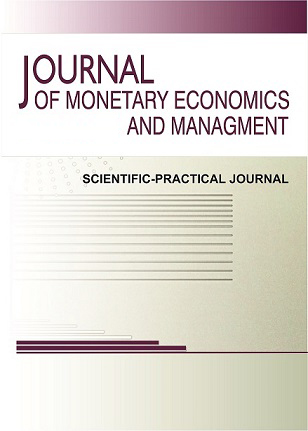graduate student
The development of the digital economy, along with the issues of providing food to the population, is receiving attention all over the world. However, due to the lack of research on the impact of digitalization on the formation of food markets, the mechanisms of state policy on food security have not been disclosed. Increasing the competitiveness of agriculture, which consists in increasing labor productivity, optimizing costs, and sustainable agricultural development, is impossible without using modern achievements of the digital economy, including in the field of agricultural product promotion. Successful implementation of digital technologies in such a low-profit industry is possible only with the active participation of the state, including by stimulating Internet connectivity in rural areas, introducing professional development programs, increasing the availability of budget financing, digitalizing the process of providing public services to agricultural producers, including simplifying the procedure for granting government loans.
food market, level of food security, digitalization, Internet, digital platform, agricultural production
1. Asalieva Z. A. Prioritety cifrovogo razvitiya regionov Rossiyskoy Federacii // Vestnik Rossiyskogo ekonomicheskogo universiteta imeni G. V. Plehanova. 2022. № 6. S. 78–88. https://doi.org/10.21686/2413-2829-2022-6-78-88
2. Kollia I., Stevenson J., Kollias S. AI-enabled safe and efficient food supply chain // Journal Not Specified. 2021. Vol. 10. P. 1–21. https://dx.doi.org/10.3390/1010000
3. Mezhdunarodnye ekonomicheskie otnosheniya: plyuralizm mneniy v epohu peremen / L. S. Revenko (red.). M.: MGIMO-Universitet, 2017. S. 271–281.
4. Townsend R., Lampietti J., Treguer D., Schroeder K., Haile M., Juergenliemk A., Hasiner E., Horst A., Hakobyan A. The future of food: Harnessing digital technologies to improve food system outcomes. Washington, DC: World Bank, 2019.
5. Lu L., Reardon T. An economic model of the evolution of food retail and supply chains from traditional shops to supermarkets to e-commerce // American Journal of Agricultural Economics. 2018. Vol. 100, № 5. P. 1320–1335. https://doi.org/10.1093/ajae/aay056
6. Barr K. Farm stops: Understanding a new model for local food distribution // Journal of Agriculture, Food Systems, and Community Development. 2025. Advance online publication. https://doi.org/10.5304/jafscd.2025.142.031
7. Hobbs Dzh. E. Cepochki postavok prodovol'stviya vo vremya pandemii COVID-19 // Kanadskiy zhurnal sel'skohozyaystvennoy ekonomiki/Obzor. 2020. URL: https://www.foodsystemsjournal.org/index.php/fsj/libraryFiles/downloadPublic/41H (data obrascheniya: 01.06.2024).
8. Krejci C. C., Marusak A. A., Mittal A., Sadeghiamirshahidi N., Beckwith S. Transportation barriers in local and regional food supply chains // Journal of Agriculture, Food Systems, and Community Development. 2025. Vol. 14, № 1. P. 141–168. https://doi.org/10.5304/jafscd.2024.141.018
9. Yun H., Lee G. The spatial digital divide in food accessibility: Food desert in Seoul, South Korea // SSRN. 2025. URL: https://ssrn.com/abstract=5049226 (ili) http://dx.doi.org/10.2139/ssrn.5049226 (data obrascheniya: 01.06.2024).
10. Ronald R. The remarkable rise and particular context of younger one-person households in Seoul and Tokyo // City & Community. 2017. Vol. 16, № 1. P. 25–46.
11. Khasanovna R. B., Vakhaevich I. M., Uvaisovich S. I., Alexandrovna M. I. Digital economy of agribusiness: Problems and development prospects // Social and Cultural Transformations in the Context of Modern Globalism / Ed. D. K. Bataev. European Publisher, 2020. Vol. 92. P. 3281–3287. https://doi.org/10.15405/epsbs.2020.10.05.436
12. Dong K., Prytherch M., McElwee L., Kim P., Blanchette J., Hass R. China’s Food Security: Key Challenges and Emerging Policy Responses. Washington, DC: Center for Strategic and International Studies (CSIS), 2024. P. 1–18. URL: http://www.jstor.org/stable/resrep58349 (data obrascheniya: 01.06.2024).
13. Bipartisan Policy Center. Making Food and Nutrition Security a SNAP: Recommendations for the 2023 Farm Bill. Washington, DC: Bipartisan Policy Center, 2023. URL: http://www.jstor.org/stable/resrep47287 (data obrascheniya: 01.06.2024).
14. Mikaelsson M. A., Dzebo A., Klein R. J. Just Transition in Supply Chains: A Business Brief. New York: United Nations Global Compact, 2023. P. 1–19.
15. Kappe K., Mikaelsson M. A., Krustok I. The EU Green Deal in turbulent times: insights from the EU Green Policy Tracker from Sweden and Estonia. Stockholm Environment Institute, 2025. Vol. 15. P. 1–15. URL: http://www.jstor.org/stable/resrep69586 (data obrascheniya: 01.06.2024).
16. Barbour L., Lindberg R., Woods J., Charlton K., Brimblecombe J. Local urban government policies to facilitate healthy and environmentally sustainable diet-related practices: A scoping review // Public Health Nutrition. 2022. Vol. 25, № 2. P. 471–487.
17. Candel J. J. L. What’s on the menu? A global assessment of MUFPP signatory cities’ food strategies // Agroecology and Sustainable Food Systems. 2019. Vol. 44, № 7. P. 919–946.
18. Reichardt K., Negro S. O., Rogge K. S., Hekkert M. P. Analyzing interdependencies between policy mixes and technological innovation systems: The case of offshore wind in Germany // Technological Forecasting and Social Change. 2016. Vol. 106. P. 11–21.
19. Kandel Dzh. Eco-social food policy design: getting food systems inside the doughnut / J. Candel // The Eco-Social Polity? : theoretical, conceptual and empirical issues / E. Domorenok, P. Graziano, K. Zimmermann (eds.). — Bristol : Bristol University Press, 2025. — Vol. 1, pp. 181–195. — (1st ed.). — DOI:https://doi.org/10.2307/jj.18323757.21.









